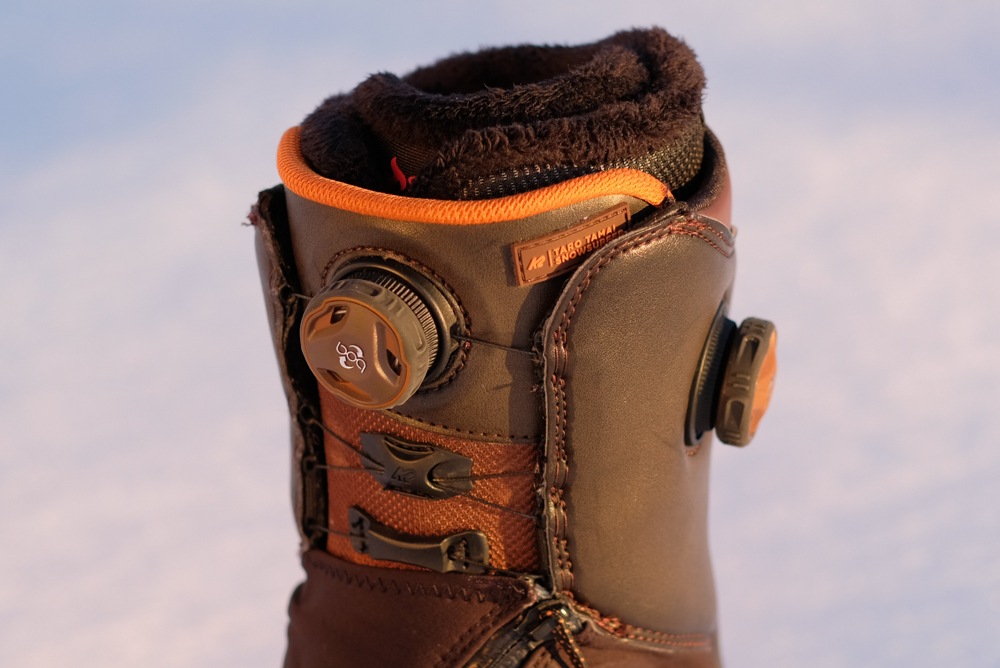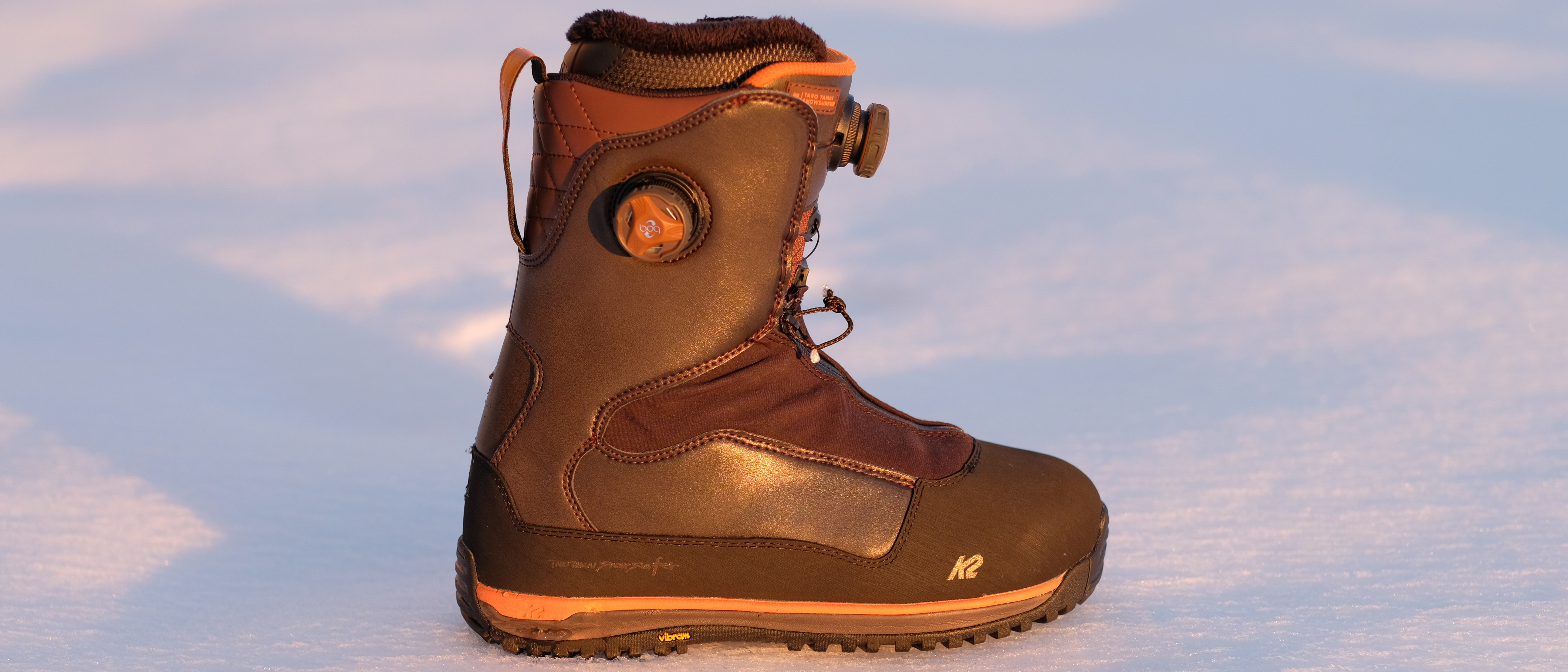The K2 Taro Tamai Snowsurfer boot is a collaboration between K2 and Gentemstick founder, Taro Tamai. Will this all mountain freestyle boot unlock your inner snowsurfer?
K2 brings us the Taro Tamai Snowsurfer boot, a soft smooth-flexing boot in its second year, aimed at riders who value the turn as a method of interacting with the terrain, much in the same way a surfer rides a wave. That sounds great, but the first thing I thought was, “Oh no, a soft boot!” Soft boots to me are what you end up with after your stiff boots have had a couple of seasons logged in them. In my experience, they usually reach peak comfort levels after 40 days, before eventually becoming too sloppy to do anything more than shoveling the driveway. I believe I think that way because up until now, the snowboard boot industry has had a clear delineation – stiff boots have the highest tech, are the most expensive and therefore are the best. Soft boots, on the other hand (or foot) typically trend towards lower build quality with lower-level pricing and don’t last as long. This is the mindset K2 are looking to change with this boot and have designed it with high end tech and build quality. The K2 Taro Tamai Snowsurfer boot features a heat moldable Intuition liner, a Vibram V4 outsole, H3 Boa Focus lacing system, and a directional flex articulating cuff.
Fit & durability
The Taro Tamai boot fits true to size. When measured in store, I’m a 10 and 10’s fit me perfectly. I had some end-of-day pressure points from the lower zone boa cables the first couple of days but they went away after heat molding.
After 50 days, the boots are still looking great. The only wear I can see is from the boa cables rubbing the material in one spot on the tongue of one boot. At this point I don’t see this becoming a critical problem. As for the boot breaking in, I have not noticed any significant packing out since they were heat molded. I think the flexible cuff really helps with this, minimizing boot breakdown around the ankles.
Liners
The Intuition liners are called SpaceHeaters and are my favourite part of the boot just because they are so comfy. I really appreciate the cut out soft sections for where your ankles bones stick out, as I usually get pressure points there from having an over pronated foot. They earn their SpaceHeater name by having silver foil underneath the insole for heat retention and extra fleece around the top. It’s nice for deep winter days but in spring conditions not so much. Also, if I spend a while in the lodge for a long lunch or at the end of the day chatting with friends, they are so warm I have to take the boots completely off!



Boa H3 Focus System

The lacing consists of the Boa H3 Focus system, which features two reels to adjust tension in both the upper and lower sections. This is my first pair of Boa boots and I had mixed feelings to start with. Yes, the ease of getting the boot on and off is wonderful. The flip side to that is the difficulty I have in getting the tightness ‘dialed’ in perfectly. I wish there was a marker of some sort to let you know how tight you had them the previous day. Some days, the fit is perfect and I’d love to be able to replicate that feeling consistently. Other days, I spend the day going back and forth between ‘too tight’ and ‘too loose’. My current strategy is to start the day with them barely snug and to tighten them little by little over the first two runs as my foot warms up the liner. It’s a lot easier to tighten the Boa system than to loosen it so it’s best to avoid any over tightening. The loosening difficulty is due to the cable unrolling completely when you pull the wheel out, which is frustrating when all you want to do is just loosen it a notch. To get around this, I hang on to the wheel as I pull it out and then manually give it a half turn before pushing back into place.
The most important thing for me is to thump the heel of the boot into the ground before tightening them first thing in the morning. Even though it feels like my foot is in where it should be, giving the boot a whack gets my heel in a touch deeper into the heel pocket. If I don’t, I get boot loosening during the day as my foot finds the extra heel space after a run. Additionally, I get pressure points on my instep as the the Boa cables lie higher on my foot than intended. With these ‘strategies’ in place, I’ve minimized the tightening difficulty and nowadays I have no problems getting the right fit right off the bat. I’ll chalk it up to the Boa learning curve.
Covering the lower Boa cables is a neoprene tongue cover. It is great for keeping out the snow that later melts and seeps into the liner. For the first week of using it, it was really tight and I had to crank the boa lower zone way too tight just to be able to close the lace cover. Luckily, it has now loosened up and is no problem. The zipper pulls have come undone a number of times so I make sure to check the knot is intact before riding. I think it’s a good design and like it, especially on powder days when I’m putting in bootpacks in thigh-deep snow!

Heat molding
It turns out that not all heat boxes in shops are the same. I was about to use a Deeluxe heat box at my local shop but luckily decided to double check with K2 first. It was a good thing I did because the temperature and time settings are different and I could have messed up these boots. For K2 boots with Intuition insoles, the heat molding temperature needs to be 119 degrees Celsius for 12 minutes. I found a K2 heat molder, had them molded properly and wow, they went from being pretty comfortable with some pressure points to being even more comfortable with no pressure points! For me molding made a huge difference, but if the boot fits you fine from the get go, then it’s not essential. The liner will mold to your foot shape anyways after a few days riding.
Sole
The sole is a Vibram V4 outsole. It’s got deep treads which provide a solid grip when hiking around. However, it also gets more powder caked in there, which ends up on your binding footbed. This is a tradeoff, as I don’t really want less grip, so an extra kick or scrape isn’t too much trouble before strapping in. One thing to note about K2 soles is that they are flatter and so longer than other brands with reduced footprints. This may affect your binding size choice if you are in between sizes. I took note of the bigger size but in the end I didn’t need to extend my binding toe ramps more than usual.

Going bindingless
In addition to snowboarding, the increased ankle mobility this boot has makes it good for pow surfing (Grassroots pow surfers/noboards/yuki ita). If I’m going bindingless, I like to completely let out the top Boa while keeping the lower Boa tight. This frees up my ankles even more. The Taro Tamai Snowsurfer boots can also work for snowskating if you’re just freeriding.
On this day, it was so convenient to get some deep laps on a pow surfer in the morning and then grab a snowboard for the afternoon, without having to change boots:
Final thoughts
This is the second year for the K2 Taro Tamai Snowsurfer boot and it’s interesting to note that last year’s version was much softer. This year the boot stiffened up quite a bit, while next year’s model will have more of a medium fit between the two. Even though it seems like they’re still working on getting the perfect flex, I found this 2018 flex to be great. They’re soft enough for my ankles to easily flex and really get more surfy with my turns, but have enough support for all mountain riding. While the whole ‘designed by Taro Tamai’ boot concept is obviously great for people with expensive powder boards who are into perfecting their carving as an art form, this boot is so much more than that. Don’t let the snowsurfer tag pigeonhole it. I have used these boots for everything this year, and whether it’s hardpack groomer carves, deep powder tree runs, powsurfing, snowskating, banked slalom racing or splitboarding, frankly I have not been let down. Granted, these won’t be the boots for dedicated park or big mountain guys, who need discipline-specific stiffness, but for all round freeriding, the K2 Taro Tamai Snowsurfer boot covers all the bases with the bells and whistles of a comfortable high end boot.
Get more information on K2 Snowboarding at their official site.
Disclosure: The K2 Taro Tamai Snowsurfer boots were provided by K2 Snowboarding.


